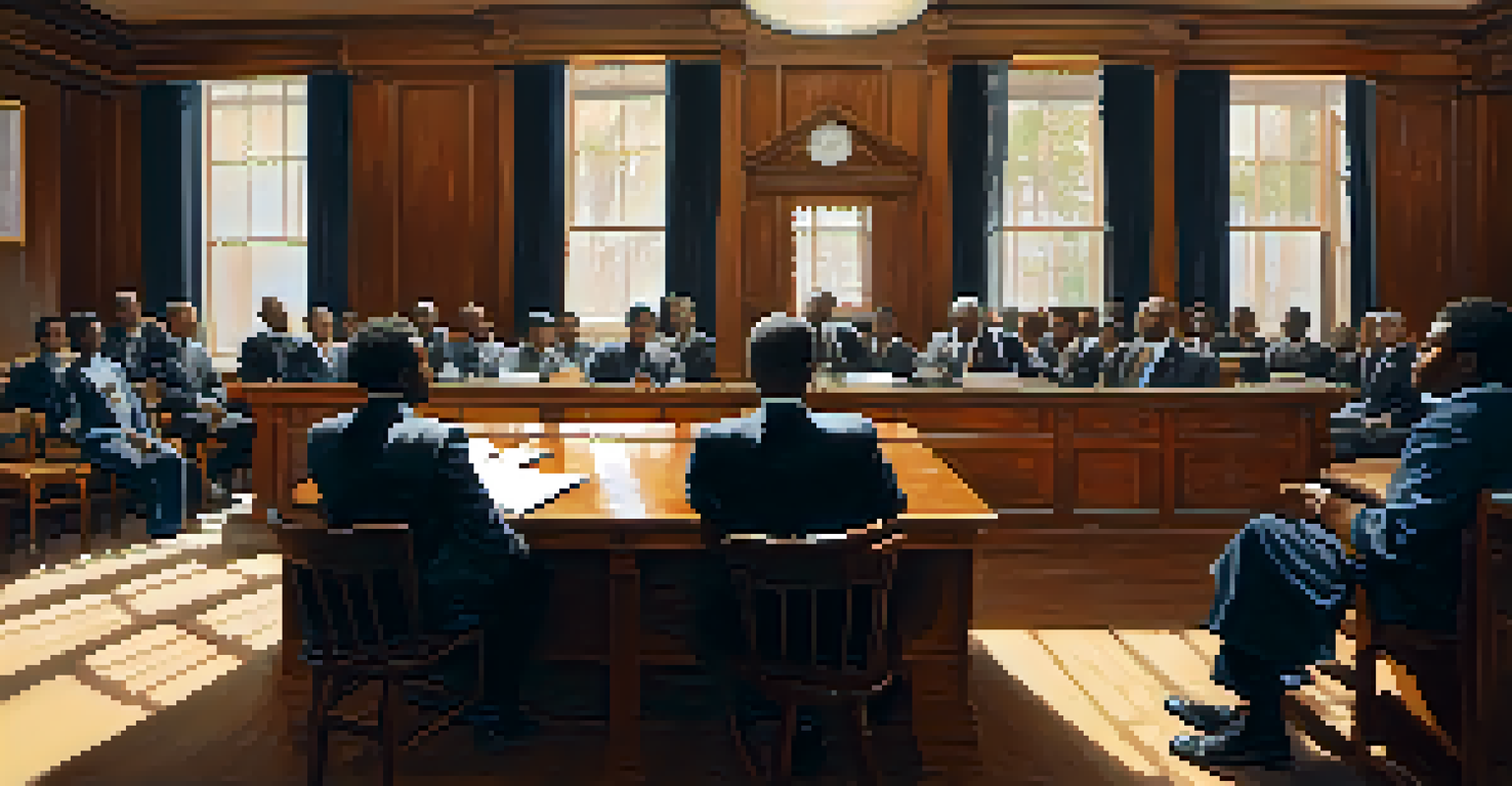Jacksonville's Sit-Ins: A Catalyst for Change in the 1960s

The Context of Jacksonville in the 1960s
In the early 1960s, Jacksonville, Florida, was a microcosm of the racial tensions prevalent across the United States. The city was marked by segregation laws that restricted African Americans from accessing certain public facilities, including restaurants and parks. This social climate set the stage for a series of protests aimed at challenging these unjust laws. As the Civil Rights Movement gained momentum nationally, local activists recognized the need for direct action to combat systemic racism in their own community.
Injustice anywhere is a threat to justice everywhere.
The local chapter of the NAACP and student groups from historically black colleges began organizing sit-ins as a form of nonviolent protest. These sit-ins drew inspiration from similar movements in other cities, particularly Greensboro, North Carolina, where students successfully desegregated lunch counters. Jacksonville's activists sought to replicate this success while also shining a light on their own struggle for equality.
These protests were not just about food or public spaces; they symbolized a broader fight for dignity and human rights. The sit-ins in Jacksonville would soon become a rallying point, galvanizing community members and drawing attention from national civil rights organizations. This combination of local action and national support was crucial in amplifying the message of equality.
The First Sit-In: A Bold Stand at Woolworth's
The first organized sit-in in Jacksonville took place at the Woolworth's lunch counter in 1960, where four African American college students took their seats in protest against segregation. This act was not simply a spontaneous decision; it was a calculated move designed to challenge the status quo. The students faced immediate hostility from customers and staff, yet they remained steadfast in their resolve to demand service.

As news of the sit-in spread, more participants joined, turning the event into a larger movement. The students were met with a mix of support and opposition, highlighting the divided sentiments in the community. Their courage inspired other young people to participate, showcasing the power of collective action in the face of adversity.
Jacksonville's Sit-Ins Spark Change
The sit-ins in Jacksonville catalyzed a community movement against segregation, showcasing the power of nonviolent protest in the Civil Rights Movement.
The Woolworth's sit-in was significant not just for its immediate impact, but also for the way it mobilized the community. It set a precedent for further sit-ins across the city, demonstrating that peaceful protests could effectively challenge segregation. This marked a turning point in the fight for civil rights in Jacksonville, as it encouraged more people to stand up against injustice.
Community Response: Support and Opposition
The sit-ins sparked a varied response from the Jacksonville community. While many rallied behind the students, there were also fierce opponents who defended the segregationist status quo. This division created a charged atmosphere, with protests met by counter-protests, highlighting the deep-seated racial tensions that existed in the city.
The time is always right to do what is right.
Supporters of the sit-ins began organizing demonstrations and fundraisers to assist those arrested during the protests. Churches, local businesses, and civil rights organizations came together to provide legal aid and resources, emphasizing the community's solidarity. This support network was vital in sustaining the movement and ensuring its continuation despite the threats and backlash faced by protesters.
On the other hand, opponents of the sit-ins resorted to intimidation tactics, including threats and violence. Some establishments faced boycotts from activists, which put economic pressure on businesses that refused to change their discriminatory practices. This complex interplay of support and opposition illustrated the high stakes of the civil rights struggle in Jacksonville.
Media Coverage: Amplifying the Message
As the sit-ins gained momentum, local and national media began to take notice. Coverage of the protests highlighted the bravery of the participants and the stark realities of segregation in Jacksonville. Photographs and news reports brought the struggle for civil rights into living rooms across the country, fostering a sense of urgency and empathy among viewers.
The media's portrayal of the sit-ins played a critical role in shaping public opinion. As images of young protesters facing hostility circulated, they sparked conversations about race and justice that transcended regional boundaries. This increased visibility helped to rally support for the movement, not just locally, but nationally as well.
Media Coverage Amplifies Protests
Local and national media coverage of the sit-ins highlighted the courage of participants and helped mobilize support for civil rights across the country.
However, the media landscape was not without its challenges. Some outlets downplayed the significance of the protests or framed them in a negative light. Activists had to navigate this complex media environment, using it to their advantage while also combating misinformation and bias.
Legal Ramifications: Court Cases and Changes
The sit-ins in Jacksonville did not just spark protests; they also led to significant legal challenges. Activists and their supporters sought to challenge the constitutionality of segregation laws through the courts. This legal strategy aimed to solidify the gains made through protest by ensuring that changes were codified into law.
One notable case was when several participants were arrested during a sit-in, prompting a legal battle that drew attention to the injustices faced by African Americans in Jacksonville. These court cases became pivotal moments in the struggle for civil rights, as they highlighted the need for legislative change to accompany grassroots activism.
Ultimately, the legal victories achieved by activists helped to dismantle some aspects of institutional racism in Jacksonville. While the journey was far from over, these court cases laid the groundwork for future progress, demonstrating the importance of both protest and legal action in the fight for equality.
The Impact of Jacksonville's Sit-Ins on Future Activism
The sit-ins in Jacksonville served as a blueprint for future civil rights activism across the nation. The success of these protests inspired similar movements in other cities, reinforcing the idea that collective action could lead to tangible change. Activists learned valuable lessons about organization, solidarity, and the power of nonviolent protest, which they carried into future struggles.
Many of the young activists involved in the Jacksonville sit-ins went on to play significant roles in the broader Civil Rights Movement. Their experiences shaped their understanding of activism and community organizing, contributing to the development of strategies that would be employed in subsequent protests. This generational transfer of knowledge was crucial in sustaining the momentum of the movement.
Legacy of Activism and Youth Involvement
The sit-ins not only inspired future civil rights activism nationwide but also emphasized the critical role of youth in demanding social justice.
Moreover, the sit-ins highlighted the importance of youth involvement in the civil rights struggle. Young people were not just passive observers; they were active participants who demanded change. This realization spurred a wave of youth-led activism, emphasizing that everyone, regardless of age, could contribute to the fight for justice.
Legacy of the Sit-Ins: Reflection and Remembrance
Decades later, the legacy of Jacksonville's sit-ins continues to resonate. They stand as a testament to the power of courage and conviction in the face of injustice. Annual commemorations and educational initiatives honor the sacrifices made by those who participated, ensuring that their stories are not forgotten.
Reflecting on these events provides an opportunity to consider the ongoing struggle for civil rights and social justice. While significant progress has been made, the fight against systemic racism persists. The lessons learned from the sit-ins remind us of the importance of vigilance and activism in creating a more equitable society.

In remembering the sit-ins, we honor the bravery of those who stood up for their rights and the rights of others. Their actions not only changed Jacksonville but also contributed to the broader narrative of the Civil Rights Movement. As we reflect on this history, it becomes clear that the journey toward justice is ongoing, and each generation has a role to play.